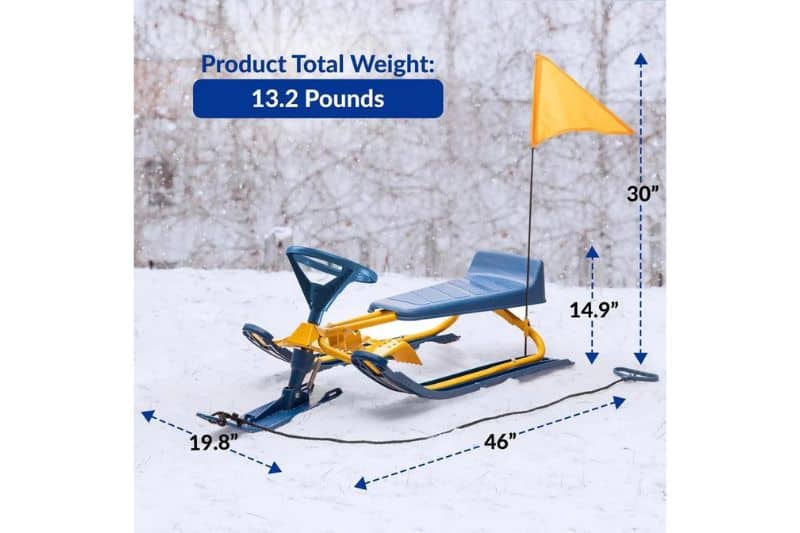When it comes to enjoying winter sports, one of the first things that comes to mind is sledding. As I prepared for a day of snowy fun, I couldn’t help but wonder, how much does a sled weigh? Especially since hauling it up the hill can be quite a workout.

It turns out that the weight of a sled can vary greatly depending on the type, size, and material used. Some sleds are made of lightweight plastic, others aluminum, and then there are the traditional wooden sleds. In general, plastic sleds tend to be lighter, while wooden ones can be heavier.
Read: How Much Does a Parakeet Weigh? (Answered)
Smaller sleds are much lighter and easier to maneuver. These sleds may weigh as little as 5 pounds (2.2 kg). Large sled types can weigh anywhere from 20-40 pounds (9-18 kg). Dog sleds can be as heavy as 45-70 pounds (20-32 kg).
Understanding Sleds
I have always been fascinated by sleds and how they glide across the snowy landscape. Sleds come in various shapes, sizes, and materials. Some are made of wood, while others are constructed from metal or plastic. Different types of sleds are used for different purposes, such as recreational sledding, dog sledding, and professional racing.

The first thing I notice when picking up a sled is its weight. The sled’s weight plays a crucial role in its performance, affecting the speed, control, and ease of use.
Smaller sleds, typically used by children, are much lighter and easier to maneuver. These sleds may weigh as little as 5 pounds (2.2 kg) and are often made from lightweight materials like plastic.

On the other hand, larger sleds designed for adults and professional races can weigh significantly more. These sleds may be constructed from heavier materials like wood or metal, which provide added durability and stability. These sled types can weigh anywhere from 20-40 pounds (9-18 kg).

Dog sleds, used in famous races like the Iditarod, are designed to carry both the driver and cargo, and therefore, they can weigh even more. These sleds can be as heavy as 45-70 pounds (20-32 kg), depending on their construction and materials.

The weight capacity of a dog sled is also significantly higher, as it needs to accommodate the rider and all the necessary supplies for the journey.
Factors Influencing Sled’s Weight
When researching sled weights, I discovered several factors that can influence how much a sled weighs. One of the most significant factors is the material used in the sled’s construction.

Sleds can be made from various materials, such as wood, plastic, steel, and aluminum. Each material contributes to the sled’s overall weight differently:
- Wooden sleds: These traditional sleds can weigh anywhere from 10 to 20 pounds, depending on the size and the type of wood used.
- Plastic sleds: These lightweight sleds typically weigh between 3 to 7 pounds, making them a more portable option.
- Steel and aluminum sleds: Metal sleds tend to weigh more than their wooden or plastic counterparts, with some models reaching around 30 pounds.
Another factor that affects the weight of a sled is its size and design. For instance:
- Sleds designed for children will generally weigh less than those designed for adults.
- Sledding tubes, which lack a rigid structure, usually weigh less than traditional sleds or toboggans.
- Racing sleds, such as those used in professional competitions, might be engineered to weigh less to enhance speed and performance.
Additionally, the type of sled will also impact its weight. Different sled styles include:
- Toboggans: These sleds have a flat, elongated design and generally weigh between 8 to 15 pounds.
- Snow racers: These sleds feature a seat and handlebars for steering and typically weigh around 10 to 20 pounds.
- Dog sleds: Designed to be pulled by dogs, these sleds can weigh upwards of 30 pounds or more, depending on the materials used and the size of the sled.
Types of Sleds
There are various types of sleds available in the market, and the weight of a sled can differ depending on the material used. In this section, I will discuss the three main types of sleds: Wooden Sleds, Plastic Sleds, and Metal Sleds.
Wooden Sleds

Wooden sleds have been around for centuries and have a classic, nostalgic charm. These sleds are made from solid wood, making them durable and aesthetically pleasing.
The weight of a wooden sled can vary depending on the type of wood used and the size of the sled. A small wooden sled typically weighs between 10-20 lbs, while a larger sled for multiple riders can range from 25-40 lbs. Some advantages of wooden sleds include:
- Durability: Wooden sleds are strong and can withstand wear and tear.
- Environmentally friendly: Wood is a renewable resource, making these sleds eco-friendly.
Plastic Sleds

Plastic sleds have become increasingly popular due to their affordable price and lightweight design. They usually weigh 5-10 lbs and are available in various sizes and colors.
The most common plastics used for sleds are high-density polyethylene (HDPE) and polypropylene (PP). Some benefits of plastic sleds include:
- Lightweight: Easier to carry and quicker to glide down snowy slopes.
- Affordable: Plastic sleds are less expensive than wooden and metal sleds.
Metal Sleds

Metal sleds are known for their durability and strength. They typically have a steel or aluminum frame with a plastic or wooden seat for added comfort.
Metal sleds can weigh between 20-40 lbs, depending on the materials used and their size. Some advantages of metal sleds are:
- Strength: Metal sleds can handle rough terrain and are less prone to breaking.
- Stability: The weight of the metal frame provides better control on fast downhills.
I hope this breakdown of the different types of sleds with their respective weights helps you choose the right sled for your needs! Enjoy the snowy slopes!
Impact of Sled Weight on Performance

I noticed that the weight of a sled significantly impacts its performance on different terrains. A lighter sled is usually more maneuverable, while a heavier sled can have better stability.
Let’s review some aspects of sled weight and their effect on performance.
In snowy conditions, lighter sleds tend to glide more efficiently over the snow surface as they exert less pressure on the snow, which reduces friction. This allows for greater acceleration and easier control of the sled. Lighter sleds are especially advantageous on packed or groomed snow, enabling quick turns and easy maneuverability.
On the other hand, heavier sleds also have their merits. In rough terrain or areas with deep, loose snow, I discovered that a heavier sled can provide better stability and traction. The added weight helps the sled push through deep snow, preventing it from being bogged down or stuck.
Additionally, heavier sleds can help carry extra gear and supplies, allowing for more prolonged trips into the wilderness.
Choosing the right sled depends on individual needs and preferences. Experimenting with different weights and sizes can help determine the optimal choice.
Considering the terrain, snow conditions, distance, and gear requirements, it’s possible to find a sled that strikes the right balance for optimum performance.
How to Determine Your Sled’s Weight?

When I first decided to figure out how much my sled weighed, I gathered all the necessary tools and chose an appropriate method. I thought of a few ways to determine the weight of my sled accurately and safely.
First, I decided to check the manufacturer’s specifications. This information is often found on the sled’s packaging or manual. If I couldn’t locate the manual, I searched online for the sled model and its specifications to see if the weight was listed.
Next, I considered using a scale to weigh my sled manually. If it was small and lightweight, I could place it on a regular bathroom scale and get a reading. If it was larger and more cumbersome, a platform or heavy-duty scale might be needed to accommodate the sled’s size and weight.
Read: How Much Does a Chair Weigh? (Detailed Guide)
When using a scale, I made sure it was accurate and correctly calibrated. I placed it on a flat, even surface to avoid inconsistencies in the reading. After weighing, I took note of the sled’s weight to ensure I had the information I needed.
In case I didn’t have access to a scale, I thought of an alternative method. By calculating the volume of my sled and then multiplying it by the material’s approximate density, I could estimate its weight. To find the sled’s volume, I measured its length, width, and height:
- Length: the distance from the front to the back of the sled
- Width: the distance from one side of the sled to the other
- Height: the distance from the sled’s base to its top
I then multiplied these measurements to get the sled’s volume, and from there, I could research the approximate density of the sled’s material (typically wood, plastic, or metal) to determine its weight. However, this method is less accurate than weighing and should be used as a last resort.
Conclusion
Sleds can vary greatly in weight depending on their type, material, and size. Small plastic sleds can weigh as little as 2-3 pounds, while larger wooden or metal sleds can weigh over 20 pounds.
During my investigation, I also noticed that the design and purpose of the sled play a significant role in its weight. For example, racing sleds are usually lightweight to reduce drag and improve speed, whereas recreational sleds prioritize durability and may be slightly heavier.
To summarize, the weight of a sled can vary significantly based on many factors. It’s essential to consider these aspects when choosing the right sled for your needs and preferences. Happy sledding!
Frequently Asked Questions
How heavy is a leg press sled?
A leg press sled usually weighs around 75 to 125 pounds, depending on the make and model. Keep in mind that this weight alone is not the only resistance you’ll encounter during your workout, as you’ll be adding weight plates to increase resistance.
What is the weight of a Rogue Slice Sled?
The Rogue Slice Sled is a popular fitness sled used for conditioning exercises. It’s well-built and durable, making it a favorite among athletes and trainers. This sled comes in at a weight of 65 pounds (29.5 kg), which allows for easy movement during exercises like sled drags and pushes.
How much does a Prowler 2 sled weigh?
The Prowler 2 sled by EliteFTS is another excellent option for anyone looking to add sled training to their workout routine. The Prowler 2 sled weighs approximately 75 pounds (34 kg). It’s designed with a sturdy frame and multiple attachment points to increase the versatility of your training.
What is the typical weight of a push-pull sled?
Push-pull sleds come in various styles, sizes, and materials. The weight of a push-pull sled can range from 50 to 120 pounds (22.7 to 54.4 kg). Like other sleds, the overall resistance during exercise depends on the added weight plates.
How much does a Power Systems sled weigh?
The Power Systems sled is a versatile training tool that can be used for a range of conditioning exercises. This sled weighs around 68 pounds (30.8 kg). It has a compact design which makes it great for users with limited storage space.
What is the weight of an F45 sled?
F45 sleds are durable and versatile sleds used for high-intensity interval training (HIIT). They weigh between 80-100 pounds and can be used for a range of exercises targeting different muscle groups.







